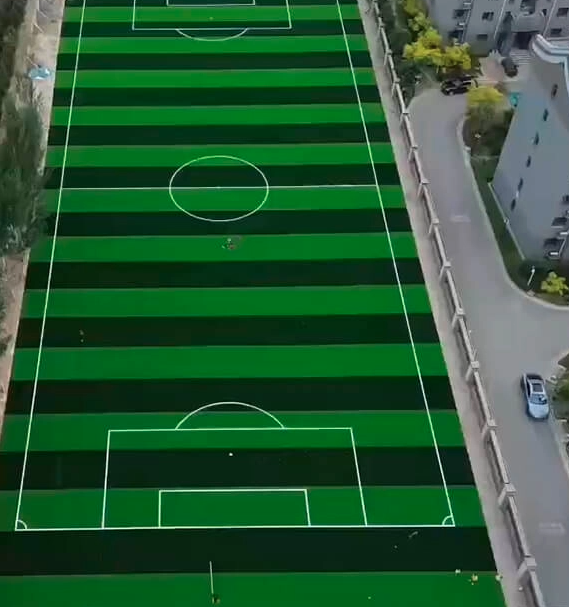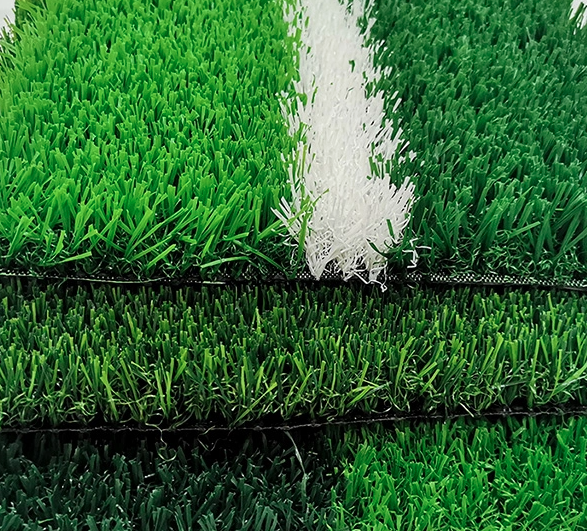
Choosing between natural vs artificial football turf is one of the most important decisions for football clubs, schools, and sports facility managers. Each surface type delivers unique advantages in durability, performance, maintenance, and long-term value. Natural football grass offers a traditional, authentic playing experience that many athletes love, while artificial football grass provides unmatched consistency and all-weather usability. In this guide, we explore all key differences, performance factors, and real-world considerations to help you select the best football grass surface for your field.
Understanding Football Turf Types
What is Natural Grass Football Turf?
Natural football grass grows from soil, either seeded or laid as sod. Common varieties include Bermuda, Kentucky Bluegrass, and Ryegrass. They provide a soft, springy surface that absorbs impacts. Players often prefer natural grass because the ball reacts differently depending on moisture, temperature, and wear.
Maintaining natural grass requires irrigation, soil care, and sunlight. Poor maintenance can lead to uneven surfaces, mud, and bare patches. Despite this, many football clubs and stadiums choose natural turf for its traditional feel and authentic playing experience.
What is Artificial Football Turf?
Artificial football turf consists of synthetic fibers like polyethylene (PE), polypropylene (PP), or nylon. It often includes rubber or sand infill for cushioning, traction, and stability. Modern artificial turf is engineered to mimic natural football grass in appearance and playability.
Advanced systems may include shock-absorbing pads to reduce joint stress and heat-resistant layers for hot climates. They can withstand heavy traffic, rain, and drought without compromising performance. Artificial turf is a preferred choice for schools, community fields, and professional stadiums looking for durability, predictability, and lower maintenance.
Key Differences Between Natural Grass and Artificial Turf
Durability and Wear
Artificial football turf maintains its condition despite intense use. Heavy matches, training sessions, or harsh weather rarely damage it. Natural football grass, however, wears down faster under high traffic. Rain or drought can cause muddy, uneven, or brittle patches, affecting ball roll and player footing.
Maintenance Requirements
Natural Grass: Mowing, watering, fertilizing, aeration, pest control, and repairing worn areas. Maintenance is labor-intensive and weather-dependent.
Artificial Turf: Brush fibers, remove debris, replenish infill occasionally, check seams. Maintenance is predictable, quick, and less costly over time.
Cost Considerations
| Feature | Natural Football Grass | Artificial Football Turf |
| Installation | $5–$12/sq ft | $10–$20/sq ft |
| Maintenance | Moderate to high | Low to moderate |
| Lifespan | 8–12 years | 10–15 years |
| Long-Term Cost | Variable | More predictable and stable |
Artificial turf requires higher upfront cost but offers lower operational expenses. Long-term budgeting favors synthetic surfaces for high-use fields.
Environmental Impact
Natural football grass absorbs CO₂, generates oxygen, and supports insects. It also helps reduce heat locally. However, it consumes significant water and often requires chemical fertilizers or pesticides.
Artificial football turf does not need watering or chemicals, which saves resources and reduces environmental strain in arid regions. Some modern turfs are recyclable. Yet, the production process consumes energy, and heat retention can create warmer playing surfaces.
Performance and Playability
Player Experience on Natural Grass
Natural football grass feels soft underfoot, reducing strain on joints. Ball roll and bounce vary naturally depending on moisture, growth, and mowing patterns. Heavy rainfall may create muddy spots, while drought can make the surface brittle. Many players and coaches prefer natural grass for its traditional feel and authentic playing conditions.
Player Experience on Artificial Turf
Artificial football turf offers consistent bounce, predictable ball roll, and firm traction. Advanced fibers reduce abrasions and stress on joints. Shock pads further protect players. Turf enables reliable gameplay year-round, regardless of weather. Clubs benefit from extended use without downtime for recovery or repairs.
All-Weather Play
Natural grass can become slippery, uneven, or damaged under heavy rain or snow. Artificial turf fields remain playable in nearly all weather conditions. Porous drainage systems prevent puddles and reduce mud. For facilities hosting multiple teams or high-frequency events, artificial turf ensures consistent training and match conditions.
Safety and Injury Considerations
Natural Grass
Natural football grass provides a naturally cushioned surface that helps absorb impacts when players run, slide, or fall. This softness can ease stress on joints and muscles, which is why many athletes prefer natural turf during long training sessions. However, the surface can change quickly due to rain, drought, or wear. Uneven patches, soft muddy spots, or loose divots may increase the risk of slips, twisted ankles, or unexpected falls. For players who are sensitive to pollen, freshly cut or blooming grass can sometimes trigger allergies, which affects comfort and performance during matches.
Artificial Turf
Artificial football turf offers a stable, consistent surface that stays even across the entire field. This helps players maintain predictable footing, reducing the chance of tripping, sudden missteps, or minor joint injuries caused by uneven ground. Because the surface is firmer than natural grass, it can cause mild abrasions—often called turf burns—when players slide aggressively. Many modern turf systems include shock pads installed beneath the surface, which soften impacts and support safer play, especially for children, older athletes, and recreational users. In warm climates, heat-retention can become an issue, so some turf designs now integrate cooling infill or heat-reduction technologies to keep the field more comfortable during hot weather.
Pros and Cons of Each Turf Type
Natural Grass
Pros:
Authentic look and traditional feel.
Soft, reducing strain on muscles and joints.
Environmental benefits: CO₂ absorption, ecosystem support.
Cons:
High maintenance: mowing, irrigation, fertilization.
Sensitive to weather and seasonal changes.
Prone to wear and damage from heavy use.
Ongoing costs can add up quickly.
Artificial Turf
Pros:
Highly durable, withstands heavy play and weather extremes.
Minimal maintenance: no watering, mowing, or fertilizing.
Consistent surface ensures predictable ball behavior.
Long-term cost savings due to reduced upkeep.
Cons:
High initial installation cost.
Slightly harder surface may affect comfort.
Can retain heat in sunny conditions.
Environmental concerns if not recycled.
| Feature / Factor | Natural Grass | Artificial Turf |
| Feel & Appearance | Authentic, soft, traditional | Consistent, modern, uniform |
| Maintenance | High: mowing, watering, fertilizing | Low: brushing, cleaning, infill checks |
| Durability | Wears easily under heavy use | Highly durable, handles frequent play |
| Weather Performance | Affected by rain, drought, seasons | Performs well in most climates |
| Comfort & Safety | Softer, lower impact | Harder surface; can cause turf burns |
| Cost Over Time | Lower install, higher upkeep | Higher install, lower long-term costs |
| Environmental Impact | Supports ecosystems | Saves water, but disposal must be managed |
![Indoor Football Turf Indoor Football Turf]()
Factors to Consider When Choosing a Football Grass Surface
Choosing between natural football grass and artificial turf depends on how the field will be used, the environment, and long-term goals. Each factor plays a major role in determining which surface delivers the best performance, safety, and value.
Usage Frequency
Fields that see constant action—daily training, weekend matches, community events—tend to wear down quickly when covered with natural grass. Heavy traffic creates bare spots, mud patches, and uneven areas that require constant repair. Artificial turf, on the other hand, maintains its shape and appearance even under intense use, making it ideal for schools, clubs, and multi-sport facilities that need reliable playing conditions every day.
Budget
Natural grass is cheaper to install, but the ongoing maintenance costs can grow fast. Mowing, watering, fertilizing, pest control, and seasonal repairs all add up over time. Artificial football grass requires a higher initial investment, yet its long-term expenses remain comparatively low. Routine brushing and occasional infill top-ups cost far less than the full maintenance cycle of a natural field, making turf a cost-effective choice over its lifespan.
Climate
Weather plays a major role in how each type of surface performs. In drought-prone regions or areas with extreme temperatures, natural grass may struggle to survive without heavy irrigation or constant care. In rainy climates, grass fields can become muddy, slippery, and quickly damaged. Artificial turf delivers steady, predictable play in nearly any climate, as it doesn’t rely on water or sunlight to stay usable. However, in cooler, mild regions, natural grass can thrive beautifully with proper care.
Sport Type
Different sports place different demands on a field. Football and soccer typically play very well on high-quality artificial turf because the consistent bounce and stable footing support fast-paced movement. Sports like field hockey and baseball also adapt well to synthetic systems. Golf and certain precision sports, however, rely heavily on the natural texture and responsiveness of real grass, making natural turf the better option for those applications.
Environmental Values
Natural grass contributes to the local ecosystem by supporting insects, cooling the surrounding air, and absorbing carbon dioxide. However, it often requires large amounts of water, fertilizers, and pesticides to stay healthy. Artificial turf eliminates the need for watering and chemicals, helping conserve resources and reduce chemical runoff. Still, sustainability-minded organizations may also consider the environmental impact of turf production and disposal when making their choice.
Installation and Long-Term Care
Installing Natural Grass
Seed or sod selection depending on climate.
Soil preparation and irrigation system setup.
Time to grow before usable, often several weeks.
Installing Artificial Turf
Prepare base and drainage.
Install turf rolls and infill carefully.
Professional setup ensures long lifespan and consistent play.
Maintenance Tips
Grass: Mow, water, fertilize, aerate, reseed.
Turf: Remove debris, brush fibers, refill infill, inspect seams.
FAQ
1. Which is better for football: natural grass or artificial turf?
Both surfaces work well for football, but artificial turf performs better for high-use fields because it stays consistent and durable, while natural grass offers a softer, more traditional playing feel.
2. Is artificial turf environmentally friendly?
It reduces water use and eliminates the need for fertilizers or pesticides, but the manufacturing and disposal process must be managed responsibly. Some modern systems use recyclable materials.
3. How long does artificial football grass last?
High-quality artificial football turf usually lasts 10–15 years, depending on usage, maintenance, and climate.
4. Is natural grass more expensive to maintain?
Yes. Natural grass requires mowing, irrigation, fertilizing, pest control, and repair, which makes it more costly over time compared to the low-maintenance routine of synthetic turf.
5. Can artificial turf be used in all weather?
Artificial turf drains quickly and stays playable in most weather conditions, including rain and snow, while natural grass can become muddy, slippery, or damaged.
Conclusion
Deciding between natural vs artificial football turf ultimately depends on your field’s usage frequency, climate conditions, maintenance resources, and long-term performance goals. Natural grass delivers the classic feel and environmental benefits many teams appreciate, while artificial football turf ensures year-round play, greater durability, and predictable performance for high-traffic facilities.
If you’re looking for professional guidance or high-quality artificial football grass solutions, Qingdao XiHY Artificial Grass Company offers advanced turf systems designed for football fields, schools, and stadiums worldwide. With reliable performance and customizable turf options, they can help you build a safer, more durable, and more cost-effective sports surface.












